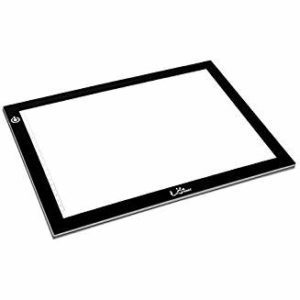
A few weeks ago I started using a light table to produce flat fields. These units use LEDs to illuminate a large screen. Apparently artists use them to do tracing, and some people use them to entertain small children.
I first bought a cheaper version, but it failed after the first power on. I then bought a LitEnergy table for about $110 on Amazon. The lighted surface is about 24″ by 33″ (size A1), so both OTAs can point at it at the same time. It has a 110 Volt power connector and a single capacitive button for control. Touch the button once and the unit powers on. Hold the button and the unit changes intensity down to a fairly dim level, or up to the brightest level. I never know if it will go up or down.
The basic unit is too bright for flats, even at a dim setting. I collected three 1/4″ smoky acrylic sheets (Filter Sheets) to put on top of the table to filter the intensity further.
Overall, it kind of works but I am not happy with it.
Issue 1: Power On
For running remotely, devices are generally left in the “On” state with their power switch. Device are turned on and off through an Internet Power Switch (Digilogger). In this case there is no On switch I can leave on all the time. I have to physically touch the On switch to power on the unit. This makes it unable to run remotely.
There is also no way to remotely adjust the light intensity.
Issue 2: Static
The unit seems to be poorly wired or grounded or something. When turned on I feel static; a couple of times I got small zaps when touching the button or the frame of the unit. The first unit displayed the same problem. I think it died as a result of one of the zaps.
When I place a filter sheet on the unit, static immediately charges the sheet. Placing the filter sheet can cause the intensity level to change as though I touched the capacitive button. Touching the sheet or the frame can also change the dimness setting on the unit, without touching the button.
In addition, the static can cause the unit to change intensity settings even without touching it. In the middle of running a set of 25 flats the intensity can suddenly change a couple of levels, causing the flat process to either fail or take bad flats. The static does not play well with the capacitive button.
Issue 3: Setting Intensity Level
It is difficult to set a particular light level on the screen. There is no indication of the currently selected level. I try to adjust the setting to the maximum level, then hold the button and count the number of dimmings, but
- the dimmings are subtle so I can be off, and
- it is hard to know when the unit is on maximum. Even if I count correctly I might have started off by 1 or 2 from maximum when I started. There really needs to be an indication of the current level setting.
Adjustment is finicky and not very reproducible.
Issue 4: LED Flicker
It turns out that the LEDs are not on constantly. At dim levels, it appears that the LEDs perhaps are turned on a few rows at a time. The resulting image shows “bars” rather than an even image. Visually the intensity looks even, but exposures less than 2.5-3 seconds are very different.
Thus, I need to select filter sheets and a light level so I get more than 3 second exposures. In practice, exposures tended to be 7-15 seconds depending on the filter. This doesn’t seem like a big deal, but if I take sets of 25 flats per filter at 15 seconds per flat, over 7 filters, at 3 binning levels, it takes over 2 hours. It is much more convenient to take flats at less than a second. If the overall process could be automated this problem would not be as serious.
To take flats over several filters I need to physically be in the observatory. For each filter/bin combination I need to select the necessary plastic sheet, adjust the dimness setting, and run the ACP Autoflat script. I might be able to run 2 or 3 filters at this sheet/setting, then I need to select a new dimness and sheet combination. It takes a couple of hours to run all of the combinations. I have to be in the observatory the entire time to continually change settings. As noted in Issue 2, I also have to watch for the light intensity shifting on its own, requiring me to restart the process.
I am looking for another alternative.
